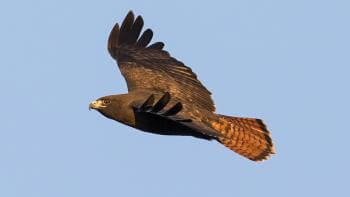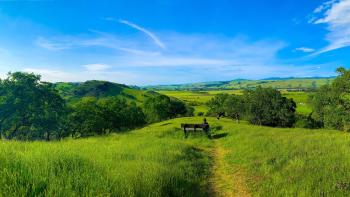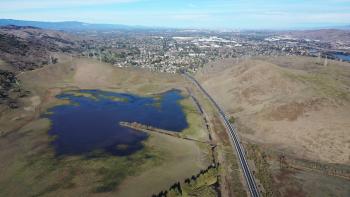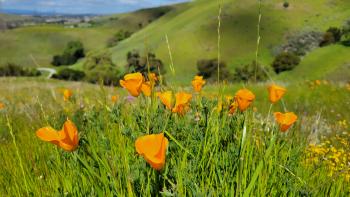Who Gives a Dam About Wetland Restoration?
This June, the Open Space Authority partnered with Peninsula Open Space Trust (POST), Alnus Ecological and Cooper Lienhart from Nature's Engineers in San Luis Obispo to build two beaver dam analogs (BDAs) in Coyote Valley’s Laguna Seca. This process-based restoration project aims to keep more water in this seasonal wetland, restore some of its natural hydrology, and benefit the plants and animals who rely on this important landscape.
A New Era for Laguna Seca
Just ten miles south of downtown San José, Laguna Seca is a historic wetland in Coyote Valley. Once spanning more than 1,000 acres and full of water for much of the year, the wetland was ditched, drained and burned for agriculture and development over the last century, leading to loss of precious habitat and increased flood risk downstream.

Laguna Seca, located in North Coyote Valley, is a historic wetland that has been a longtime focal point for restoration.
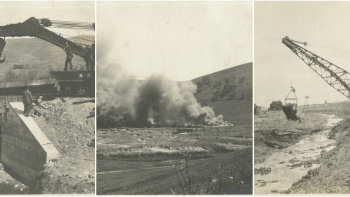
In 1916, the Laguna Seca wetland was ditched, drained and burned for agriculture.
Despite these human-made changes, Laguna Seca is still an important resource for aquatic wildlife and migratory birds, and also helps provide clean water and flood protection for downstream San José communities.
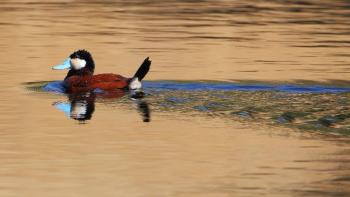
The ruddy duck is one species of migratory bird that relies on Laguna Seca’s wetland habitat.
In 2019, the Open Space Authority, Peninsula Open Trust (POST) and the City of San José, invested $93.5 million to permanently protect North Coyote Valley, signaling the start of a new era for the heavily altered and abused landscape.
Now, we’re looking to beavers, fondly known as “nature’s engineers,” to inspire these first steps toward restoration.
Leave it to Beavers
“We’re mimicking the natural behavior of beavers and their beneficial impacts on the environment by building our own version of a beaver dam,” said Rachel Clemons, Watershed Restoration Specialist with the Open Space Authority. “What we’re hoping is that these beaver dam analogs will back up water and help retain it in the wetland for longer into the dry season.”
Keeping more water in Laguna Seca can benefit both wildlife and water conservation. A longer “hydroperiod” is expected to improve local water quality and overall wetland health, which further supports a diverse array of native species dependent on wetlands for food, breeding and migration. There is hope that a restored Laguna Seca could also potentially support rare aquatic species, such as the California red-legged frog, California tiger salamander and Northwestern pond turtle.
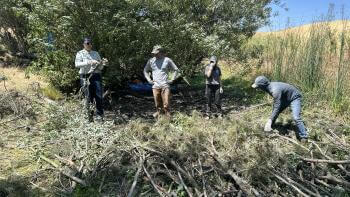
Working with Nature’s Engineers and Alnus Ecological consultants and partners from POST, the City of San José, Valley Habitat Agency and Valley Water, Authority staff constructed the BDAs out of non-native pine trees, mud, and willow tree branches, mimicking the techniques that real beavers use when making dams.
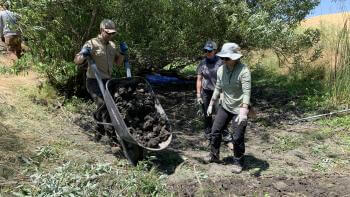
The BDAs were constructed in an artificial drainage ditch within the Laguna Seca wetland. Although the ditch is dry in the summer, staff hope that once the wet season returns, these BDAs will keep more water in Laguna Seca for longer.
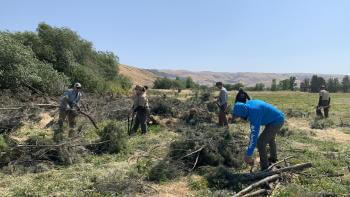
BDAs are a natural and cost-effective way to increase water retention within Laguna Seca, increasing both depth of water and amount of time that water stays in the wetland.
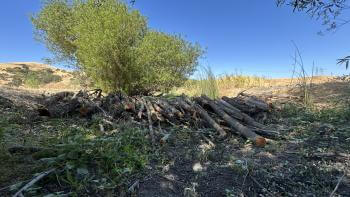
Over just two days, staff built two BDAs, each 4-5 feet tall.
What’s Next?
Post-construction, staff will visit the project site regularly to monitor effectiveness and make any needed repairs. Although BDAs are inherently temporary structures, they are designed and managed to remain for one to five years. Maintenance may involve repairing damage, replacing washed-out materials and adjusting the structure as needed.
Staff will monitor a variety of metrics to measure the success of the dams, including groundwater and surface water level and depth, timing and duration of flooding and the health and density of wetland plants.
Imitation, Not Reintroduction
While beavers are native to the South Bay, the purpose of this project is not necessarily to restore their presence in Laguna Seca. “This is more about replicating the benefits that beavers provide in nature,” said Clemons. “They create and maintain wetlands and help maintain balance in the ecosystem.”
Maybe one day we’ll see beavers at Laguna Seca, but for now we’re simply “taking a page from their book.”
Learn More
Restoration of Laguna Seca is being planned through the Coyote Valley Conservation Areas Master Plan (CVCAMP), which is led and managed by the Open Space Authority in close partnership with the Peninsula Open Space Trust (POST) and City of San José. Work on CVCAMP is funded by the Open Space Authority with the generous financial support of POST, Santa Clara County Parks Department, California Wildlife Conservation Board, California Department of Water Resources and California State Coastal Conservancy. Learn more about CVCAMP on our website.
To learn more about beavers in the Bay Area, check out this past webinar recording from our friends at POST!
